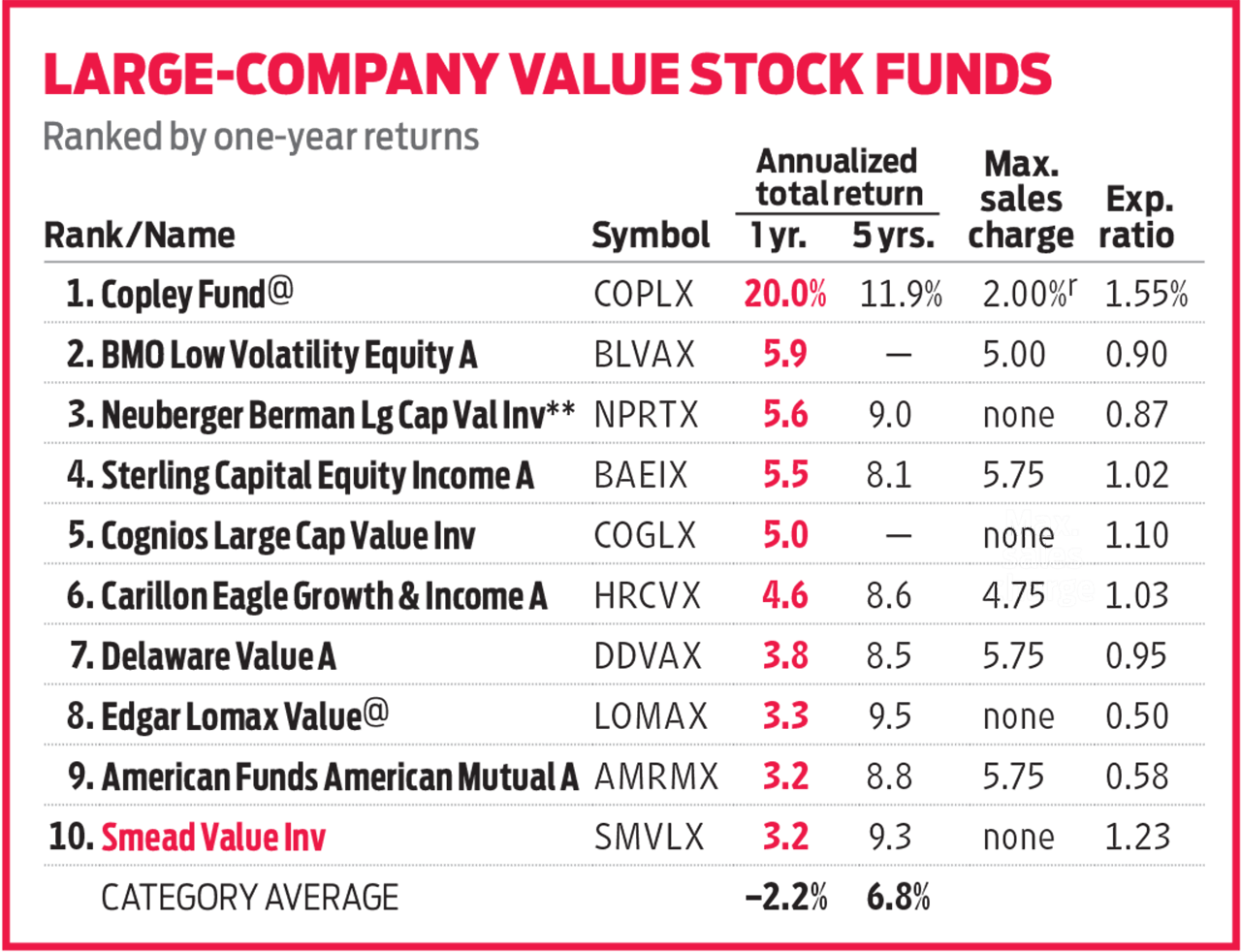Smead Value Fund Focuses on the Long Term
This concentrated fund looks for a few high-quality stocks at bargain prices.

When a mutual fund holds a limited number of stocks, investors should brace themselves for occasional short-term volatility. Consider Smead Value (SMVLX), a fund that invests in 26 large-company stocks. Over the past three years, the fund has been about 11% more volatile than Standard & Poor’s 500-stock index, and it lost $1.19, on average, for every $1 drop in the index.
Such is life for concentrated-portfolio managers investing for the long term, says comanager Bill Smead. But for investors who have been willing to stomach the ride over the years, owning the fund has paid off. The fund has outpaced the S&P 500 in eight of the past 10 calendar years, including 2018 through early December. Over a 10-year span, the fund’s 15.2% annualized return beats the S&P and 97% of large-company value-oriented stock funds.
The fund’s managers use an eight-point checklist to identify excellent firms selling at bargain prices. Among the criteria: strong competitive advantages against peers, a long history of profitability and high levels of free cash flow (cash profits left over after capital outlays). They are always on the hunt for stocks in the proverbial doghouse and will buy a stock only if it trades at a price-earnings or price-to-free-cash-flow ratio that’s less than its average over the previous five to 10 years.
From just $107.88 $24.99 for Kiplinger Personal Finance
Become a smarter, better informed investor. Subscribe from just $107.88 $24.99, plus get up to 4 Special Issues

Sign up for Kiplinger’s Free Newsletters
Profit and prosper with the best of expert advice on investing, taxes, retirement, personal finance and more - straight to your e-mail.
Profit and prosper with the best of expert advice - straight to your e-mail.
As the managers construct the portfolio, they rely on their checklist (Smead estimates about 80 companies on the market check all eight boxes on their list) as well as a forward-looking view on economic and consumer trends. For example, the managers’ belief that drivers are shifting toward electric and hybrid vehicles means that the fund holds no energy stocks, which make up 10.5% of the average large-company value fund. “Playing oil now is like investing in oats and hay in 1910,” Smead says.
The managers also hope to capitalize on a demographic shift, with the number of Americans ages 30 to 45 increasing 40% over the next 15 years. Target, homebuilder NVR and Walt Disney are plays on the theme. “This generation will spend on things they never used to care about,” Smead says. “We want to own where they shop, where they live and the entertainment they watch.”

Profit and prosper with the best of Kiplinger's advice on investing, taxes, retirement, personal finance and much more. Delivered daily. Enter your email in the box and click Sign Me Up.

Ryan joined Kiplinger in the fall of 2013. He wrote and fact-checked stories that appeared in Kiplinger's Personal Finance magazine and on Kiplinger.com. He previously interned for the CBS Evening News investigative team and worked as a copy editor and features columnist at the GW Hatchet. He holds a BA in English and creative writing from George Washington University.
-
 Santa Claus Rally at Risk as Tech Stocks Slump: Stock Market Today
Santa Claus Rally at Risk as Tech Stocks Slump: Stock Market TodayThe Nasdaq Composite and Dow Jones Industrial Average led today's declines as investors took profits on high-flying tech stocks.
-
 7 Ways to Save Money on Almost Everything
7 Ways to Save Money on Almost EverythingHigh prices got you down? These strategies can help you reap deep discounts on everyday spending.
-
 My Top 10 Stock Picks for 2026
My Top 10 Stock Picks for 2026Each year, we ask an expert to pick 10 stocks that have the potential to beat the market over the next 12 months. Here are his choices for 2026.
-
 The 5 Best Actively Managed Fidelity Funds to Buy and Hold
The 5 Best Actively Managed Fidelity Funds to Buy and Holdmutual funds Sometimes it's best to leave the driving to the pros – and these actively managed Fidelity funds do just that, at low costs to boot.
-
 The 12 Best Bear Market ETFs to Buy Now
The 12 Best Bear Market ETFs to Buy NowETFs Investors who are fearful about the more uncertainty in the new year can find plenty of protection among these bear market ETFs.
-
 Don't Give Up on the Eurozone
Don't Give Up on the Eurozonemutual funds As Europe’s economy (and stock markets) wobble, Janus Henderson European Focus Fund (HFETX) keeps its footing with a focus on large Europe-based multinationals.
-
 Vanguard Global ESG Select Stock Profits from ESG Leaders
Vanguard Global ESG Select Stock Profits from ESG Leadersmutual funds Vanguard Global ESG Select Stock (VEIGX) favors firms with high standards for their businesses.
-
 Kip ETF 20: What's In, What's Out and Why
Kip ETF 20: What's In, What's Out and WhyKip ETF 20 The broad market has taken a major hit so far in 2022, sparking some tactical changes to Kiplinger's lineup of the best low-cost ETFs.
-
 ETFs Are Now Mainstream. Here's Why They're So Appealing.
ETFs Are Now Mainstream. Here's Why They're So Appealing.Investing for Income ETFs offer investors broad diversification to their portfolios and at low costs to boot.
-
 Do You Have Gun Stocks in Your Funds?
Do You Have Gun Stocks in Your Funds?ESG Investors looking to make changes amid gun violence can easily divest from gun stocks ... though it's trickier if they own them through funds.
-
 How to Choose a Mutual Fund
How to Choose a Mutual Fundmutual funds Investors wanting to build a portfolio will have no shortage of mutual funds at their disposal. And that's one of the biggest problems in choosing just one or two.